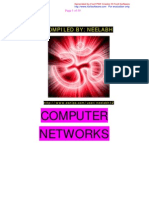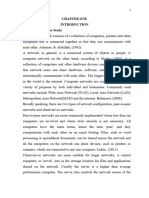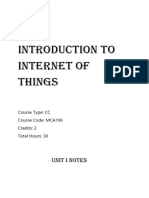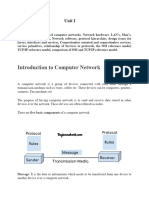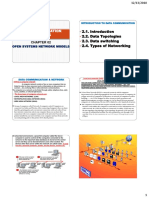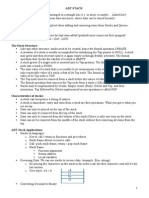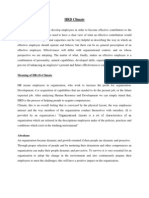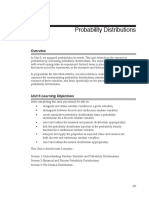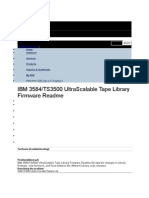CHAPTER 1: INTRODUCTION TO
NETWORKING
1.1 What is a Network?
A group of computers that can communicate with each other, share
resources (such as hard disk and printer) and access remote hosts or other
network, then it is known as a network system.
The development of the personal computer brought about tremendous
change for business, industry, science, and education. A wide variety of
computer system and software are available to satisfy a range of users
needs. For each application or type of computer, there are also a variety of
users, in office, homes and schools.
In recent years, computing power has more effectively harnessed the use
of systems that permit resources to be shared, where resources include
computing power, software and input/output units. The concept that
enables the sharing of resources is called connectivity and is achieved by
the use of integrated computer system referred to as a network.
1.2 Basic Components of Network
The most common components of a network are:
Terminal
Workstation
Server
Network interface card
Communication media
Network operating system
Peripheral devices
1.2.1 Terminal
Terminal
Over the years, the data terminal market has increased substantially and
there are now literally hundreds of manufactures and many different kinds
1-1
�CS163 CHAPTER 1: INTRODUCTION TO NETWORKING
if terminal. However, the fact is that all of these terminals have been
designed primarily to input and display information in some form or
another. Therefore, even though specific characteristics such as screen size
and keyboard layout may differ, they can generally be categorized into
three simple groups.
1. Dumb Terminals
Dumb terminals are those which have limited functions and are driven
with information from a host computer. Normally, they consist of a
Cathode Ray Tube (CRT) display screen with a full alphanumeric
keyboard and can be connected directly to a computer system (host
computer) through some sort of communications interface. In most
cases, data is transmitted directly through the communication interface
as it is typed on the keyboard.
2. Intelligent Terminals
The category of intelligent or programmable terminals is probably the
largest and widest ranging group. Unlike dumb terminals, intelligent
terminals are equipped with a processor that can support an instruction
set to direct the basic functions of the terminal. Like any other type of
computer that has a processor, these terminals normally have
additional memory and storage devices such as disc drives.
Intelligent terminal are, therefore, capable of stand-alone processing
and can support a variety of software applications which, in turn,
enable them to support a variety of communications interfaces through
the use of emulation program. This is also means that, unlike dumb
terminals, intelligent terminals are able to use addresses and
sophisticated access method to transmit and receive messages.
3. Graphic Terminals
Graphic terminals are display devices that provide a means not only for
displaying data in graphical form, but also for manipulating and
modifying the data presented. Generally, graphic terminal keyboards
have a number of specific or programmable function keys in addition
to the full alphanumeric keys of a normal keyboard and the resolution
of the display screen is normally a lot higher to enable more detailed
displays
1-2
�CS163 CHAPTER 1: INTRODUCTION TO NETWORKING
1.2.2 Workstation
Workstation
A workstation is a client. More specifically, it is a standalone computer
equipped with its own processor and system and application software. It
can perform its functions independent of the network. To expand its
resources and knowledge, it may get connected to a network.
1.2.3 Server
Network plays one of two basic roles at any given moment, the computer
is either acting s a client or as a server. A server is a computer that shares
its
Resources across the network, and a client are one that accesses shared
resources. Depending on the size and requirements of the network, servers
can be classified as below:
1. File Server
A file server allows user to share files. It several LAN users need
access to an application such as word processing, only one copy of the
application software needs to reside on a file server. This copy can be
shared among all the users. When a user requests to start an
application, that application is downloaded into the users workstation.
Consider the saving in disk space in a company having 100 users for
application package that requires 10 MB of disk storage. Storage on
the file server requires only 10 MB of disk space for all users. Storing
the same application on 100 users local disk drives will require 1,000
MB of disk space. This is only an example of one application. Same
logic can be applied when hundreds of different application programs
needed.
2. Database Server
The database server was developed to solve the problem of passing an
entire file over the medium. The most common example of a database
server is the SQL server. Structured Query Language (SQL) is standard
database definition, access, and update language for relational
database. An SQL server accepts a database request, accesses all
necessary records locally, and then sends only the result back to the
requester (not the whole database).
1-3
�CS163 CHAPTER 1: INTRODUCTION TO NETWORKING
3. Print Server
Print server allows anyone on the network to have access to a printing
service.
4. Disk Server
It is server with large storage. A portion of storage is given to each user
to store their files/data. It is very useful in university where each
student is given a user account with password and some storage space
in disk server. Once the student completes the education the same
space can be assigned to new student.
5. Dedicated Vs Non-Dedicated Server
Many networks will let their user run standard programs while their
computer is simultaneously functioning as a server to others. A
computer that both runs standard programs and lets other user see its
data at the same time is said to be non-dedicated server. Non-
dedicated servers can be clever way of setting up a small LAN without
having to buy any extra system. Dedicated server are specially
assigned for network management and provided no general-purpose
services.
1.2.4 Network Interface Card
NIC
Attaching a computer to a network requires a physical interface between
computer and the networking medium. For PCs, this interface resides in a
special network interface card (NIC), also known as network adapter or a
network card that plugs into an adapter slot inside the computers case.
Laptops and other computers may include built-in interface or use special
modular interface such as PC card interface, to accommodate a network
adapter of some kind.
For any computer, a NIC performs following crucial tasks:
1. It establishes and manages the computers network connection.
2. it translates digital data( of source computer) into signals (appropriate for the
networking medium) for outgoing messages, and translates from signals into digital
computer data for incoming messages.
3. Converts serial incoming data via cable into parallel data to for CPU, and vice versa.
1-4
�CS163 CHAPTER 1: INTRODUCTION TO NETWORKING
4. It has some memory, which acts as a holding tank or buffer. It buffers the data to
control the data flow.
1.2.5 Communication Media
Cable
Non-dedicated servers can be clever way of setting up a small LAN
without having to buy any extra system. Dedicated server are specially
assigned for network management and provided no general-purpose
services.
Increase in infrastructure cost
Increased complexity of software
Increased administrative overheads
Increased dependency
1.3 Exercises
List and describe the basic components of a network with their
function.
List the functions of NIC.
Distinguish between dedicated and non-dedicated server.
List and describe the advantages and disadvantages of networking.
List different types of server and their purpose.
1-5
�CS163 CHAPTER 1: INTRODUCTION TO NETWORKING
1-6


